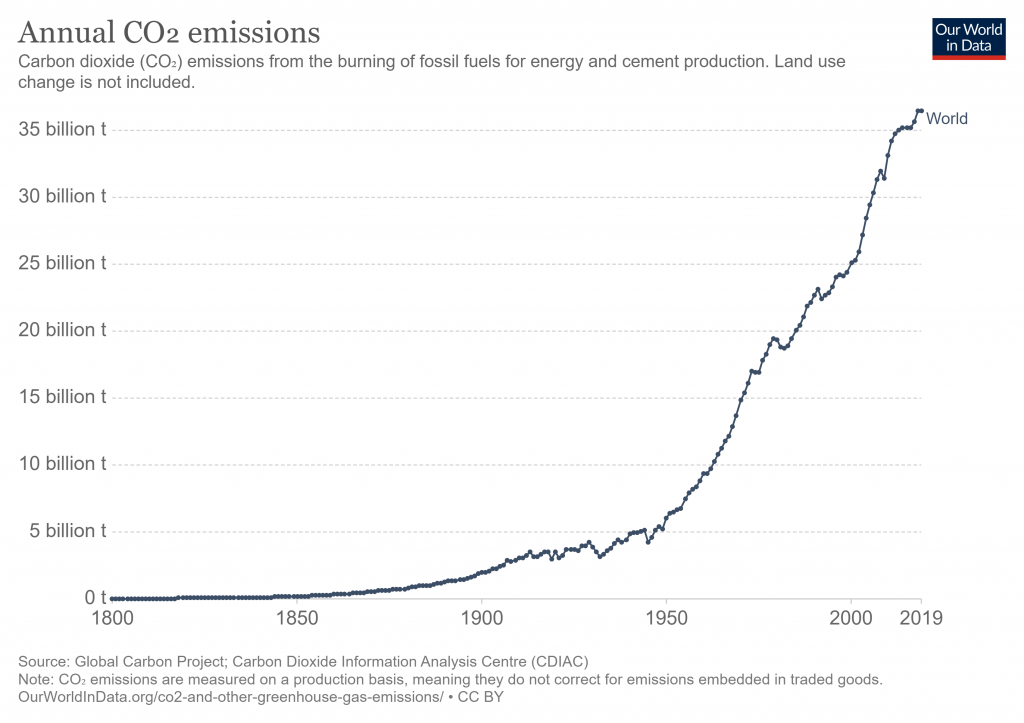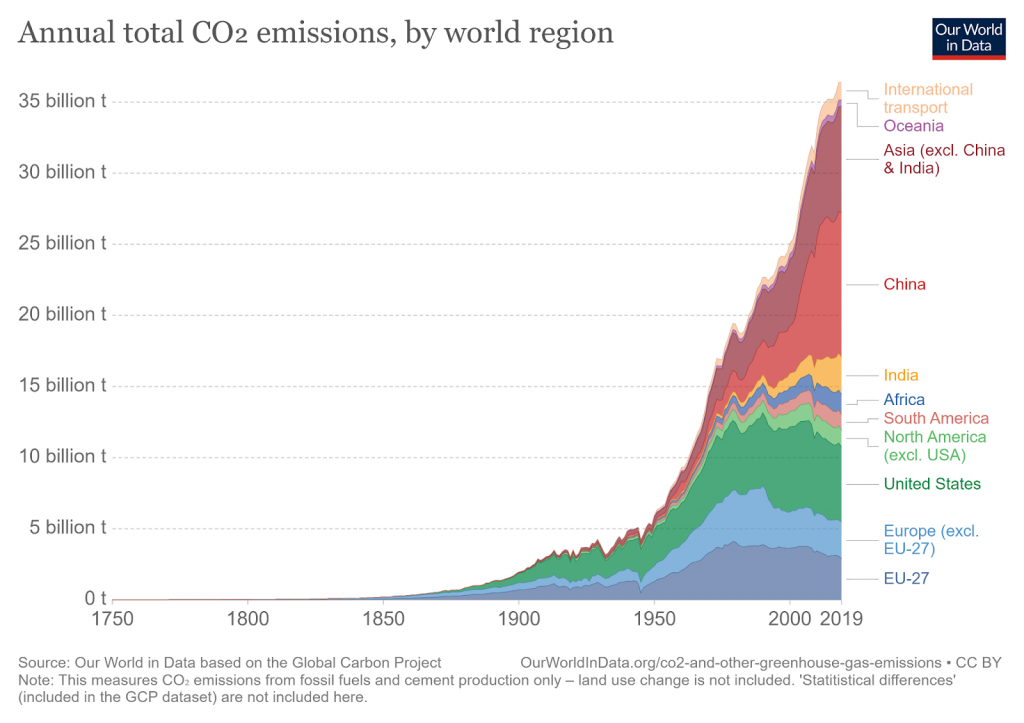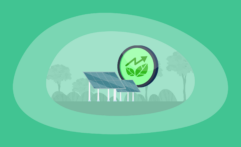Carbon Offsets Explained: All You Need to Know
Affiliate Disclosure
Hey fellow impactful ninja ?
You may have noticed that Impactful Ninja is all about providing helpful information to make a positive impact on the world and society. And that we love to link back to where we found all the information for each of our posts.
Most of these links are informational-based for you to check out their primary sources with one click.
But some of these links are so-called "affiliate links" to products that we recommend.
Why do we add these product links?
First and foremost, because we believe that they add value to you. For example, when we wrote a post about the environmental impact of long showers, we came across an EPA recommendation to use WaterSense showerheads. So we linked to where you can find them. Or, for many of our posts, we also link to our favorite books on that topic so that you can get a much more holistic overview than one single blog post could provide.
And when there is an affiliate program for these products, we sign up for it. For example, as Amazon Associates, we earn from qualifying purchases.
What do these affiliate links mean for you?
First, and most importantly, we still only recommend products that we believe add value for you.
When you buy something through one of our affiliate links, we may earn a small commission - but at no additional costs to you.
And when you buy something through a link that is not an affiliate link, we won’t receive any commission but we’ll still be happy to have helped you.
What do these affiliate links mean for us?
When we find products that we believe add value to you and the seller has an affiliate program, we sign up for it.
When you buy something through one of our affiliate links, we may earn a small commission (at no extra costs to you).
And at this point in time, all money is reinvested in sharing the most helpful content with you. This includes all operating costs for running this site and the content creation itself.
What does this mean for me personally?
You may have noticed by the way Impactful Ninja is operated that money is not the driving factor behind it. It is a passion project of mine and I love to share helpful information with you to make a positive impact on the world and society. However, it's a project in that I invest a lot of time and also quite some money.
Eventually, my dream is to one day turn this passion project into my full-time job and provide even more helpful information. But that's still a long time to go.
Stay impactful,
The global climate crisis threatens our planet’s environmental, economic, and social health. Reducing greenhouse gas (GHG) emissions and our carbon footprint is necessary to maintain a sustainable planet for future generations. And one tool to help achieve this could be carbon offsets. So we had to ask: What are carbon offsets really and could they help us mitigate climate change?
Carbon offsets are monetary investments in environmental projects that reduce CO2 emissions elsewhere and attribute it to you. They do not directly reduce your carbon footprint and are only as effective as the underlying carbon offset projects are. Yet, they are one tool to mitigate climate change.
Keep reading to find out what carbon offsets are, the impact you can have with them both individually and globally, their benefits and drawbacks, and why they may not be the most effective way to mitigate climate change.
The Big Picture of Carbon Offsets
We already have governmental-level policies in place to reduce greenhouse gas emissions (GHGs), but how do we reduce emissions from activities where sustainable alternatives are not yet widely available? The answer just might be carbon offsets.
Carbon offsets are a way to reduce carbon emissions beyond what we each can achieve through individual actions. They are measured in tons of carbon dioxide (CO2) equivalents and are bought and sold through international brokers, online retailers, and trading platforms.
“Carbon Offset: a way for a company or person to reduce the level of carbon dioxide for which they are responsible by paying money to a company that works to reduce the total amount produced in the world, for example by planting trees”
Oxford Dictionary
Carbon offsets can play a crucial role in reducing our carbon footprint, the amount of CO2 emissions associated with an individual or an entity and one of the ways we measure the effects of human-induced global climate change. It primarily focuses on the GHGs associated with consumption, but also includes other emissions such as methane, nitrous oxide, and chlorofluorocarbons.

To ensure a healthy planet for future generations, we must reduce our carbon emissions. And one way to do this is by utilizing carbon offsets.
| What carbon offsets are | Reductions in GHG emissions that are used to compensate for emissions occurring elsewhere |
| How carbon offsets work | You purchase offsets on behalf of a large corporation or on the voluntary market. Your money is used to fund projects that reduce GHG emissions |
| The impact of carbon offsets on your own emissions | Carbon offsets do not directly reduce your carbon footprint |
| The impact of carbon offsets on global emissions | Carbon offsetting mitigates the problem, but it doesn’t work at the core issue of reducing overall carbon emissions |
| The overall effectiveness of carbon offsets on reducing carbon emissions | Carbon offsetting is effective if projects are additional, permanent, meet certain key criteria and project standards, and do not engage in greenwashing |
| The main benefits of carbon offsets | Balancing off GHG emissions, improving air quality, maintaining healthy ecosystems, supporting green jobs |
| The main drawbacks of carbon offsets | Planting trees can’t replace cutting CO2 emissions, offsets are to a great extent PR schemes, and offsets often contribute to climate colonization |
How Do Carbon Offsets Work
Essentially, carbon offsets are reductions in GHG emissions that are used to compensate for emissions occurring elsewhere. Because GHGs are found everywhere in our atmosphere, cutting GHGs at any location on earth provides emission reduction benefits.
How Do Carbon Offsets Reduce Carbon Emissions
The goal of carbon offsets is to reduce carbon emissions in order to mitigate climate change.
- Carbon offsets can represent direct or indirect emission reductions. Purchasing carbon offsets funds carbon emission reduction projects which either prevent carbon from entering the atmosphere or remove it once it’s already there.
When you hear the words “carbon offset”, think about the term “compensation”. Offsets represent the reduction, avoidance, destruction or sequestration of the equivalent of a ton of carbon in one place to “offset” an emission taking place somewhere else. Carbon offsets are designed for situations where emissions are impossible to reduce because you can use the funds to reduce emissions in other areas.
What Impact Do Carbon Offsets Have on Your Own Carbon Emissions
One of the best ways we can aid in the fight against global climate change is to reduce our carbon footprint. To do this, we first have to reduce our own carbon emissions.
- Carbon offsets do not directly reduce your carbon emissions.
Carbon offsets do not directly reduce your own carbon emissions. When you purchas e carbon offset, it only makes others reduce their carbon footprint to compensate for your carbon footprint.
What Impact Do Carbon Offsets Have on Global Carbon Emissions
Every year we pump over 36 billion tons of carbon into the atmosphere, fueling climate change. Carbon offsets aim to reduce global carbon emissions and mitigate this phenomenon.
- Carbon offsets mitigate the problem, but they do not work at the core issue of reducing overall carbon emissions.
Carbon offsets do not have a significant impact on global carbon emissions because in comparison to our 36 billion tons of carbon emissions, carbon offsets for only ~1 billion tons of CO2 have been listed for sale on the voluntary market. Meaning that only about 0.8-1% of our annual CO2 emissions are offset.
The COVID-19 pandemic triggered the largest decrease in energy-related carbon emissions since World War II, a decrease of 2 billion tonnes. However, emissions rebounded quickly and rose by 6% in 2021 to 36.3 billion tonnes, their highest ever level. This indicates that the earth is still warming at an accelerated rate, and still not enough is being done to implement direct carbon reduction measures.

How Effective Are Carbon Offsets in Reducing Carbon Emissions
Carbon offsets can be effective at reducing carbon emissions under certain conditions.
- Different carbon offset projects have different effectiveness rates, and offsetting is effective only if projects are additional, permanent, meet certain key criteria and project standards, do not engage in greenwashing, and are realized.
Different carbon offset projects have different effectiveness rates. Direct CO2 removal is the most effective category of offsets followed by renewable energy, energy efficiency, and carbon sequestration.
To be beneficial, carbon offsets must be additional and permanent. That means that these projects must reduce GHG emissions more than would have occurred if there were no projects to begin with, and they must remain in effect forever, in the sense that a tree planted to offset carbon should never be removed.
Key criteria to look for in a carbon offset program include:
- A clearly defined protocol that determines which types of projects are eligible and how emission reductions will be measured
- Independent third-party verification of compliance with the protocol
- Registration of offsets in an offset registry, which tracks each credit with a unique serial number to ensure it is only used once
- Transparency in project implementation and reporting
Carbon offset project standards are also used to ensure transparency and quality in the creation, quantification, and verification of offset projects. They include:
- Verified Carbon Standard (VCS): The world’s leading voluntary GHG program, with 1700+ projects having removed 630+ million tons of CO2 from the atmosphere.
- Gold Standard: A certification that has issued 134 million carbon credits from 1700+ projects based in more than 80 different countries.
- Climate Action Reserve (CAR): The premier carbon offset registry for the North American carbon market having issued over 150 million offset credits since its inception in 2001.
- American Carbon Registry (ACR): The first private voluntary greenhouse gas registry in the world.
But most importantly, carbon offsets must be realized in order to be effective. A main problem with carbon offsets is that the number of sellers on the voluntary carbon market exceeds the buyers by about 600-700 million tons. Meaning that only about 300-400 million tons of CO2 offsets actually get realized.
When offsets are listed but realized, we are not mitigating any effects of climate change. In return, the rates of temperature rise, sea-level rise, ice melting, and ocean acidification continue to increase as the earth warms.
What Are the Main Benefits and Drawbacks of Carbon Offsets
Carbon offsets have benefits and drawbacks that are important to understand before you decide whether or not to purchase them. Supporters tout their ability to improve environmental health while opposers assert that they don’t really work.
What Are the Main Benefits of Carbon Offsets
Carbon offsets can help reduce your overall GHG emissions to balance off your personal carbon footprint to fight climate change – at least in the short term. But their benefits even go beyond that.
- Improves Air Quality: Degradation of air quality as a result of carbon emissions is a serious issue. In 2009, the U.S. government declared CO2, CH4, N2O, hydrofluorocarbons (HFCs), perfluorocarbons (PFCs), and sulfur hexafluoride (SF6) threats to the public health and welfare of current and future generations. Reducing C02 emissions would lead to improved public health in terms of asthma, respiratory allergies, airway diseases, and lung cancer.
- Protects Ecosystems: Healthy ecosystems have been linked with cleaner air, water, and food. Protecting forest habitats increases carbon sequestration and defends against erosion. Protecting agricultural land ensures a robust, secure, and prosperous food system. Protecting aquatic ecosystems ensures a readily available supply of freshwater. Lastly, protecting biodiversity protects human health because many plants and animals are used in modern medicines.
- Supports Green Jobs: The renewable energy sector employed 12 million people worldwide in 2020, with solar energy making up the bulk of those jobs. Renewable energy jobs continue to increase as we start to realize just how beneficial renewable energy is for our environment.
If used correctly, carbon offsets can provide environmental, economic, and social benefits that go beyond just reducing GHG emissions.
What Are the Main Drawbacks of Carbon Offsets
The global carbon offset market was estimated at nearly $10 billion in 2010 and has since grown to represent anywhere between $40 billion and $120 billion. But despite all of its success, carbon offsetting is not without its limitations.
The following 9 major limitations should be taken into account when implementing carbon offset programs:
- When you purchase a carbon offset, you are paying someone else to cut their emissions so you don’t have to cut your own emissions.
- Global warming is still occurring at an accelerated rate because offsetting CO2 emissions does not cut CO2 emissions at the source, it only mitigates emissions.
- If carbon offset projects are not additional and permanent, they can make climate change worse because they are not offsetting any carbon.
- The richest of the world emit the majority of the world’s carbon. Offsets are just licenses to pollute with the benefit of aiding those in developing countries.
- The varying levels of effectiveness of carbon offset programs make it difficult to choose one that actually reduces emissions. Direct CO2 removal is the most effective category of offsets followed by renewable energy, energy efficiency, and carbon sequestration.
- If a carbon offset program is not carried out until the end, then we cannot reap the program’s benefits. For example, planting trees is a common offset program that is only effective if those planted trees are protected during their life span for the carbon benefits to be realized.
- We emit far more CO2 than we can offset because of carbon sink (e.g., atmosphere, forests, soil, ocean) limitations.
- Of the credits for 1 billion tons of CO2 listed on registries, only about 300-400 million tons of CO2 offsets actually get realized.
- Investing in non-verified credits, not prioritizing in-house emissions reductions, and double-counting carbon credits are methods of greenwashing. Also, companies may advertise a specific program, but it may be just for public attention instead of to actually reduce emissions.
These limitations make the current voluntary carbon market fragmented and complex, which leads to confusion, inconsistencies, and general distrust of the system.
Why Are Carbon Offsets Important to Fight Climate Change
Using carbon offsets can reduce our consumption of and reliance on fossil fuels (i.e., coal, oil, and natural gas). Reducing your consumption of these, in turn, reduces your carbon footprint, which has huge impacts on environmental, economic, and public health. A reduced carbon footprint due to lower GHG emissions can mitigate the effects of climate change, improve public health, boost the economy, and maintain plant and animal diversity.
What are Better Alternatives to Carbon Offsetting
The main argument against carbon offsets is that they don’t really work. Instead of substituting offsetting carbon emissions, we should instead cut the emissions directly at the source. Basically, if we stop emissions from getting into the atmosphere in the first place, we won’t have to worry about offsetting.
The fastest way to cut emissions directly at the source is to reduce your carbon footprint. And these reduction measures don’t have to involve drastic changes either. Actions that may seem small can have a big impact because those small changes add up! You can reduce your carbon footprint in three main areas of your life: household, travel, and lifestyle.
Reduce your household footprint:
- Wash with cold water: Washing clothes in cold water could reduce carbon emissions by up to 11 million tons. Approximately 90% of the energy is used to heat the water, so switching to cold saves also saves energy.
- Replace incandescent bulbs with fluorescent bulbs: Fluorescent bulbs use 75% less energy than incandescent ones, saving energy and thus reducing electricity demand and greenhouse gas emissions.
Reduce your travel footprint:
- Fly less: Aviation accounts for around 1.9% of global carbon emissions and 2.5% of CO2. Air crafts run on jet gasoline, which is converted to CO2 when burned.
- Walk or bike when possible: The most efficient ways of traveling are walking, bicycling, or taking the train. Using a bike instead of a car can reduce carbon emissions by 75%. These forms of transportation also provide lower levels of air pollution.
Reduce your lifestyle footprint:
- Switch to Renewable Energy Sources: The six most common types of renewable energy are solar, wind, hydro, tidal, geothermal, and biomass energy. They are a substitute for fossil fuels that can reduce the effects of global warming by limiting global carbon emissions and other pollutants.
- Recycle: Recycling uses less energy and deposits less waste in landfills. Less manufacturing and transportation energy costs means less carbon emissions generated. Less waste in landfills means less CH4 is generated.
- Switch from single-use to sustainable products: Reusing products avoids resource extraction, reduces energy use, reduces waste generation, and can prevent littering.
- Eat less meat and dairy: Meat and dairy account for 14.5% of global greenhouse gas emissions, with beef and lamb being the most carbon-intensive. Globally, we consume much more meat than is considered sustainable, and switching to a vegan or vegetarian diet could reduce emissions.
- Take shorter showers: Approximately 1.2 trillion gallons of water are used each year in the United States just for showering purposes, and showering takes up about 17% of residential water usage. The amount of water consumed and the energy cost of that consumption are directly related. The less water we use the less energy we use. And the less energy we use, the less of a negative impact we have on the environment.
Because offsetting is an indirect way and not a direct way of reducing emissions, it alone will not be enough to significantly reduce global carbon emissions. Direct measures of emission reductions, such as reducing individual energy use and consumption, are better alternatives to offsetting.
Final Thoughts
Carbon offsets allow us to reduce GHG emissions in ways we wouldn’t be able to accomplish individually. Offset programs involving direct CO2 capture, renewable energy, energy efficiency, and carbon sequestration can reduce GHG emissions, which improves air quality, protects ecosystems, and supports green jobs. When implemented properly, these benefits can outweigh the drawbacks.
Carbon offsets are a good place to start if you want to get into the carbon-emission reduction game, but in order to be effective in the long-term, we must not rely on them solely. Cutting emissions from the source and then offsetting the remainder is the best way to reduce our carbon footprint and provide the highest environmental benefits.
Stay impactful,

Sources
- United Nations Framework Convention on Climate Change: The Paris Agreement
- United States Environmental Protection Agency: Offsets and RECs: What’s the Difference?
- David Suzuki Foundation: Are carbon offsets the answer to climate-altering flights?
- Impactful Ninja: Why Is a Carbon Footprint Bad for the Environment?
- Britannica: Carbon Footprint
- Our World in Data: Annual CO2 Emissions
- Britannica: Carbon Offset
- GreenBiz: REC vs. Carbon Offset – Do You Know the Difference?
- Yale Environment 360: Is the ‘Legacy’ Carbon Credit Market a Climate Plus or Just Hype?
- International Energy Agency: After steep drop in early 2020, global carbon dioxide emissions have rebounded strongly
- International Energy Agency: Global CO2 emissions rebounded to their highest level in history in 2021
- Carbon Offset Guide: Additionality
- Carbon Offset Guide: Permanence
- Natural Resources Defense Council: Carbon Offsets 101
- Terrapass: Project Standards
- Verra: Verified Carbon Standard
- The Gold Standard: Homepage
- Gold Standard: Gold Standard Impact
- Climate Action Reserve: About Us
- Climate Action Reserve: Registry
- American Carbon Registry: Homepage
- National Wildlife Federation: Climate Change
- Impactful Ninja: How Effective Is Carbon Offsetting Really? Here Are the Facts
- United States Environmental Protection Agency: Endangerment and Cause or Contribute Findings for Greenhouse Gases under the Section 202(a) of the Clean Air Act
- National Institute of Environmental Health Sciences: Asthma, Respiratory Allergies and Airway Diseases
- National Institute of Environmental Health Sciences: Cancer
- Carbon Brief: Climate change will hit ‘endemic’ plants and animals the hardest, study warns
- One Green Planet: How Saving Wildlife Benefits Humans – In Ways We Really Need
- World Health Organization: Biodiversity and Health
- International Renewable Energy Agency: Renewable Energy and Jobs – Annual Review 2021
- Impactful Ninja: What Are the Biggest Carbon Offsetting Limitations? (All 9 Explained)
- Vox: Can you really negate your carbon emissions? Carbon offsets, explained.
- Impactful Ninja: What Are the Biggest Carbon Offsetting Limitations? (All 9 Explained)
- The Nature Conservancy: Why We Can’t Afford to Dismiss Carbon Offsetting
- The Guardian: World’s richest 1% cause double CO2 emissions of poorest 50%, says Oxfam
- World Resources Institute: Setting the Record Straight About Renewable Energy
- United States Agency for International Development: Scaling up energy efficiency in developing countries
- GreenPeace: The biggest problem with carbon offsetting is that it doesn’t really work
- ClientEarth: What is a carbon sink?
- Yale Environment 360: Is the ‘Legacy’ Carbon Credit Market a Climate Plus or Just Hype?
- Edie: Carbon offsetting – How are businesses avoiding greenwashing on the road to net-zero?
- McKinsey Sustainability: A blueprint for scaling voluntary carbon markets to meet the climate challenge
- Impactful Ninja: What Is the Carbon Footprint of Coal Energy? A Life-Cycle Assessment
- Impactful Ninja: What Is the Carbon Footprint of Oil Energy? A Life-Cycle Assessment
- Impactful Ninja: What Is the Carbon Footprint of Natural Gas? A Life-Cycle Assessment
- Impactful Ninja: 4 Main Reasons Why Reducing Your Carbon Footprint Is Important
- The Ocean Foundation: Reduce Your Carbon Footprint
- Cold Water Saves: Washing Laundry In Cold Water Protects A Lot More Than Just Our Clothing.
- Energy Information Administration: Renewable Energy Explained
- Energy Star: Compact Fluorescent Light Bulbs (CFLs) and Mercury
- Our World in Data: Where in the world do people have the highest CO2 emissions from flying?
- Our World in Data: Which form of transport has the smallest carbon footprint?
- Zero Waste Europe: Reusable vs Single Use Packaging
- Carbonbrief: Interactive – What is the climate impact of eating meat and dairy?
- Stop Waste: Recycling and Climate Protection
- Impactful Ninja: Is Taking Long Showers Bad for the Environment?
- United States Environmental Protection Agency: Showerheads




